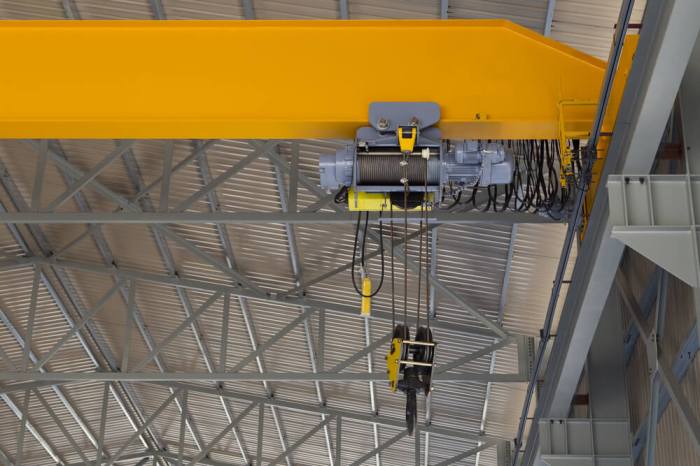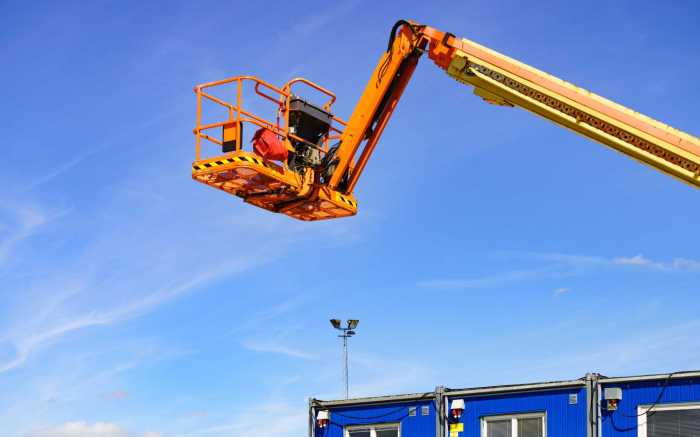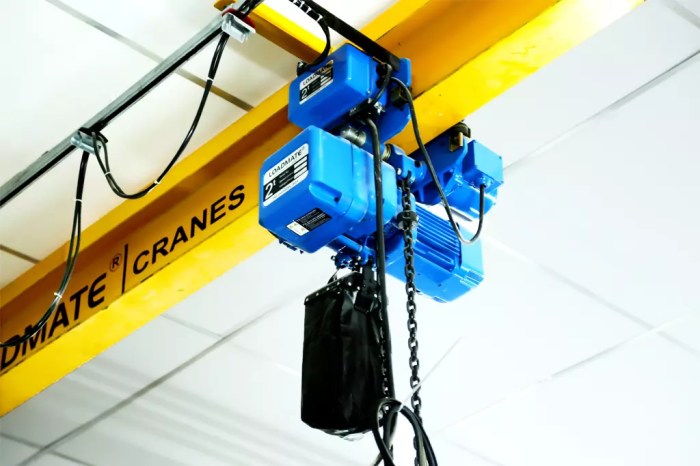To lift heavy loads all chain hoists use a – To lift heavy loads, all chain hoists use a simple but effective mechanism that has been employed for centuries. This article will delve into the intricacies of chain hoists, exploring their fundamental principles, diverse types, and vital safety features. We will also examine the various applications where chain hoists excel and compare them to other lifting equipment.
Chain hoists are indispensable tools in construction, manufacturing, and other industries that require the safe and efficient lifting of heavy objects. Understanding their operation, capabilities, and limitations is crucial for ensuring safe and successful lifting operations.
1. Chain Hoist Mechanism

Chain hoists are mechanical devices used for lifting and lowering heavy loads. They consist of a chain, a hoist body, and a load hook. The chain is wrapped around a sprocket or drum, which is driven by a hand-operated or motorized gear system.
When the chain is pulled, the load is lifted. Chain hoists are commonly used in various industries, including construction, manufacturing, and automotive.
Types of Chain Hoists, To lift heavy loads all chain hoists use a
- Manual chain hoists: Operated by pulling a chain, typically used for lighter loads.
- Electric chain hoists: Powered by an electric motor, providing greater lifting capacity and speed.
- Pneumatic chain hoists: Driven by compressed air, offering portability and explosion-proof operation.
- Lever chain hoists: Utilizes a lever mechanism for lifting, suitable for precise load positioning.
2. Load Capacity and Lifting Height
The load capacity of a chain hoist refers to the maximum weight it can safely lift. It is determined by factors such as the strength of the chain, the gear ratio, and the design of the hoist body. The lifting height is the vertical distance the load can be raised.
It is influenced by the length of the chain and the height of the hoist body.
| Model | Load Capacity (tons) | Lifting Height (ft) |
|---|---|---|
| CM Lodestar | 0.5
|
10
|
| Ingersoll Rand Air Hoist | 0.25
|
15
|
| Yale Lever Hoist | 0.25
|
10
|
3. Safety Features
Chain hoists incorporate various safety features to ensure safe operation. These include:
- Load limiters: Prevent overloading by automatically stopping the hoist when the load exceeds a predetermined limit.
- Upper and lower limit switches: Restrict the travel of the load to prevent overwinding or underwinding.
- Chain guides: Keep the chain aligned and prevent it from jumping off the sprockets.
- Regular maintenance and inspection: Essential for ensuring the reliability and safety of the hoist.
Safety Precautions
- Inspect the hoist and chain before each use.
- Do not overload the hoist.
- Ensure the load is securely attached to the hook.
- Operate the hoist on a stable and level surface.
- Never leave a suspended load unattended.
4. Applications

Chain hoists are widely used in various applications, including:
- Construction: Lifting and positioning materials, such as beams, panels, and equipment.
- Manufacturing: Moving heavy machinery, assembling products, and loading/unloading materials.
- Automotive: Servicing vehicles, lifting engines, and handling heavy components.
- Mining: Raising and lowering equipment and materials in underground operations.
- Shipbuilding: Positioning and installing large components, such as engines and propellers.
5. Maintenance and Repair
Routine maintenance is crucial for ensuring the longevity and safety of chain hoists. This includes:
- Lubrication: Apply lubricant to the chain, gears, and bearings regularly.
- Inspection: Check for wear, damage, or corrosion on the chain, sprockets, and other components.
- Chain replacement: Replace the chain when it shows signs of wear or damage.
| Maintenance Task | Frequency |
|---|---|
| Lubrication | Monthly |
| Inspection | Quarterly |
| Chain replacement | As needed |
6. Comparison with Other Lifting Equipment: To Lift Heavy Loads All Chain Hoists Use A

Chain hoists offer advantages and disadvantages compared to other lifting equipment:
| Equipment | Advantages | Disadvantages |
|---|---|---|
| Chain hoists | Compact, portable, low cost, precise load positioning | Limited lifting height, manual operation can be slow |
| Electric hoists | Higher lifting capacity, faster operation, remote control | More expensive, requires electrical power |
| Cranes | Very high lifting capacity, wide reach, can cover large areas | Expensive, complex to operate, requires specialized training |
FAQ Section
What is the maximum load capacity of a chain hoist?
The load capacity of a chain hoist varies depending on the specific model and manufacturer. Generally, chain hoists have load capacities ranging from a few hundred pounds to several tons.
How high can a chain hoist lift?
The lifting height of a chain hoist is also model-dependent. Chain hoists can typically lift loads to heights of several meters or even tens of meters.
What safety features are incorporated into chain hoists?
Chain hoists typically incorporate safety features such as overload protection, load limiters, and anti-kickback mechanisms to ensure safe operation and prevent accidents.